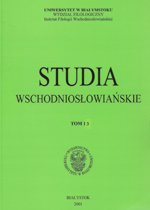U początków Świętej Rusi. Koncepcje monarchiczne metropolity kijowskiego Iłariona (XI w.) i ich związek z bizantyńską „teologią polityczną”
At the Beginning of Holy Russia. Monarchical Concepts of the Metropolitan of Kiev – Hilarion (11th Century) And Their Relationship With the Byzantine “Political Theology”
Author(s): Zofia A. BrzozowskaSubject(s): Studies of Literature, Political history, Ukrainian Literature, 6th to 12th Centuries
Published by: Wydawnictwo Uniwersytetu w Białymstoku
Keywords: Hilarion; a word about law and grace; Kievan Rus; the influence of Byzantine culture; homiletics;
Summary/Abstract: In the work of the Kievan Metropolitan Hilarion from the mid 11 th century, known as the Sermon on Law and Grace, we can find the earliest testimony of the penetration of Byzantine political elements into the East Slavic area. The Head of the Russian Church, highly educated, fluent in Greek, familiar with patristic tradition and medieval Eastern Christianity literature, seems to have no doubt that the imperial and princely authority come from God. Moreover, in connection with Justinian’s Novel 6, he calls for the need of consistent cooperation between the monarch and the clergy who manage the Church. Praising the grand prince of Kiev, Vladimir the Great, on the pages of the Sermon on Law and Grace, he creates his literary image in accordance with the canons functioning in Byzantine literature. An interesting issue is the issue of preliminaries, which appear in the text by Hilarion. The Metropolitan never named the Kievan prince as the Emperor/Tsar, but called him “Khagan” – a word taken from the language systems of Russia’s eastern neighbours.
Journal: Studia Wschodniosłowiańskie
- Issue Year: 2014
- Issue No: 14
- Page Range: 29-39
- Page Count: 11
- Language: Polish

